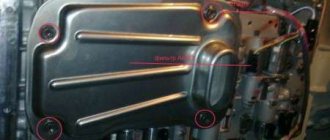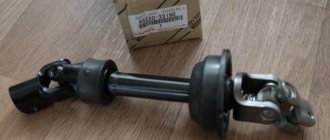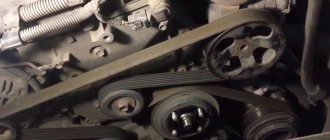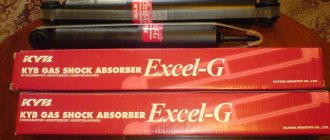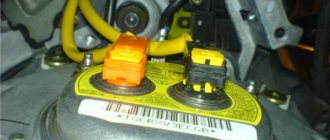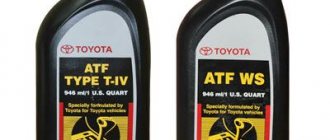Toyota Land Cruiser Prado is a frame SUV with medium dimensions. The car was developed by the famous Japanese manufacturer Toyota.
In 1987, the manufacturer presented consumers with the first generation of this SUV. The presented car was named Land Cruiser 70 series, but for some foreign markets it was positioned as Bundera or Land Cruiser II. After some time, the model was given one single initial name common to all markets. In 1996, the first generation was discontinued.
Mass production of the second generation started in 1996. The new product became known as the Toyota Land Cruiser Prado 90. The release of this model at that time was aimed at creating competition for the Mitsubishi Pajero SUV, which was then in great demand. The second generation is a direct successor to classic SUVs, but the demand for it was not so great. This is primarily due to the urban design, as well as the small displacement of the 5VZ-FE and 1KZ-TE engines. For this generation, independent front suspension was used for the first time, which was transferred along with the new platform. As for the latter, the manufacturer took the platform from the 4Runner model as a basis.
The car was restyled in 1999. Then the manufacturer equipped the model with a number of improved systems aimed at ensuring increased safety. A year later, further improvements were made, but they already affected the technical component: a three-liter 1KD-FTV diesel engine became available. In 2002, for most markets, including domestic Japanese, mass production of this generation was completed, but in the Venezuelan market, the Toyota Land Cruiser Prado was available until 2009. Here he was given the new name Meru. This version differed from the standard ones in that it did not have wheel arch extensions and was equipped only with the 5VZ-FE power unit.
The third generation has become recognizable under the name Toyota Land Cruiser Prado 120 series. The same platform used in the previous generation was taken as a basis. The new car entered mass production in 2002 in two body styles: three-door and five-door. In this regard, the wheelbase length is 2455 millimeters for the three-door model and 2790 millimeters for the five-door model. Also, five-door versions can be equipped with a third row of seats.
The third generation was perhaps the richest in terms of the proposed power plants. For consumers, the manufacturer offered four gasoline, one naturally-aspirated diesel and two turbocharged diesel engines. Now the line of engines has the following units:
- 2TR-FE. It is a gasoline four-cylinder in-line engine with a total displacement of 2.7 liters. Rated output power is 163 horsepower;
- 3RZ-FE. It is a gasoline four-cylinder in-line engine with a total displacement of 2.7 liters. The unit has a maximum power of 105 horsepower;
- 5VZ-FE. It is also a gasoline engine, but already a V-shaped six-cylinder engine with a displacement of 3.4 liters. The engine has a maximum output power of 185 horsepower;
- 1GR-FE. This is a gasoline, also V-shaped six-cylinder engine with a total displacement of 4 liters. It has a maximum power of 249 horsepower, which is quite high;
- 1KD-FTV. Diesel four-cylinder in-line engine with a total displacement of 3 liters. The engine is turbocharged, Common Rail fuel system, and also has 16 valves. Peak power reaches 163 horsepower (before August 2004, later 166 horsepower). For the Japanese and European markets, power is 173 horsepower;
- 1KZ-TE. It is a diesel four-cylinder in-line power plant, which has a displacement of 3 liters, a turbocharging system, a mechanical injection pump and 8 valves;
- 5L-E. It is a diesel four-cylinder in-line engine with a total displacement of 3 liters. Its maximum power is 95 horsepower.
How much oil to fill
Second generation J90, 1996-2002
The 1996 Land Cruiser Prado was positioned as the main competitor to the Mitsubishi Pajero.
In comparison, the Prado stood out with its stylish “urban” design, which on the one hand could be considered an advantage. But on the other hand, at that time the class of fashionable SUV cars was at an early stage of development, and was in demand only in the affordable price category of the RAV4. In this regard, the demand for the more expensive Prado turned out to be less than expected, and Pajero remained the leader in this segment. But in technical terms, everything about the Prado was at a high level: the car was built on the 4Runner N185 platform and had an independent front suspension. In 1999, a restyling took place, as a result of which safety improved and the new 1KD-FTV diesel became available. Oil in transfer case VF3B: volume – 1.2 liters; tolerance and viscosity: API-GL-3; SAE 75W-90
Oil in the front axle gearbox: volume – 1.1 liters; rear – 2.3-2.9 liters; tolerance and viscosity: API-GL-5; SAE 85W-90
Third generation J120, 2002-2009
Land Cruiser 120 is built on a modernized platform of its predecessor. The design has changed slightly, especially in the front part of the body - the radiator grille has become more massive, and the headlights have also become larger. The wheelbase has increased to 2790 mm (previously 2455 mm), which made it possible to install a third row of seats. The car received two 4WD options: permanent all-wheel drive with a Torsen locking differential, as well as with connected front wheels. However, the second option was only available for models with manual transmission and 3RZ and 5L engines, which were supplied to the Middle East. In general, the Land Cruiser 120 engine range consisted of petrol engines with a volume of 2.7 liters (2TR-FE, 3RZ-FE, 163 and 150 hp, respectively), 3.4 liters (5VZ-FE, 185 hp) and 4.0 ( 1GR-FE, 249 hp). The line of diesel engines consisted of engines 1KD-FTV (3.0, 163-166 hp), 1KZ-TE (3.0) and 5L-E (3.0, 95 hp).
Oil in transfer case: volume – 1.0 liters; tolerance and viscosity: API-GL-3.4; SAE 75W-90, 80W-90
Oil in the front axle gearbox: volume – 1.4 liters; rear – 2.4 liters; tolerance and viscosity: API-GL-5; SAE 75W-90, 80W-90
Fourth generation J150, 2009-2020
The 4th generation Land Cruiser had the same platform from the 120 Series, as well as a wheelbase of 2790 mm similar to its predecessor. Despite this, the size of the SUV has increased due to the strengthening of the spar supporting frame. Thus, thanks to design improvements, the bending rigidity of the structure has increased, which made it possible to achieve better safety indicators during crash tests. The car is supplied to Russia with petrol engines of 2.7 and 4.0 liters (163-249 hp), as well as with a 2.8 liter diesel engine (177 hp). The car is available with a five- or seven-seater cabin, is equipped with permanent all-wheel drive with a locking differential, and also has an automatic transmission in all trim levels. In 2021, the second Prado update took place.
Oil in transfer case: volume – 1.4 liters; tolerance and viscosity: API-GL-4.5; SAE 75W-90, 80W-90
Oil in the front axle gearbox: volume – 1.4 liters; rear – 2.5-2.7 liters; tolerance and viscosity: API-GL-5; SAE 75W-90, 80W-90, 90W-140
Oil for transfer case, gearbox and axles of Toyota Land Cruiser Prado
Toyota Land Cruiser Prado is a mid-size SUV that is an affordable alternative to the large Land Cruiser model. Entered production in 1984. The main features of the Prado include its relatively compact size and decent cross-country ability combined with good driving performance compared to its closest analogues. In the premium class, the car represents the luxury Lexus GX family. Since 2009, the fourth generation Prado has been produced, which is a “relative” of the flagship Land Cruiser. Since then, the car has undergone two major upgrades, which took place in 2013 and 2021.
What oil to use
Original
MG Gear Oil Special II GL-3,4,5 75W-90 oil is poured into the transfer case of a Toyota Land Cruiser Prado SUV. Hypoid Gear Oil SX API-GL-5 85W-90 is suitable for the differential (gearbox) and axles. As for viscosity, SAE 70W, 80W or 85W is suitable for winter use, and SAE 90, 140 or 250 is used mainly in summer. In Russian operating conditions, the most popular is multi-grade oil with SAE 75W-80, 80W-85, 80W-90 or 75W-90.
Unoriginal
Before purchasing a suitable oil for the transfer case, gearbox and axles of a Chevrolet Captiva SUV, you need to pay attention to several factors
In particular, choosing the right brand is important: Mannol, Total, Eneos, ZIC, Castrol, Kixx, etc.
Next, it will be a good idea to choose the type of oil. In this case, synthetic oil is more fluid, suitable for SUVs of recent years. Accordingly, mineral water or semi-synthetics are recommended for older cars. It has a relatively thick consistency, which means there is less chance of leaks in the presence of microcracks or gaps between contact pairs. Another important criterion when purchasing non-original oil is compatible API-GL-3, 4 or 5 approval. The higher the rating, the more oil additives. For the transfer case of the Land Cruiser Prado SUV in the first years of production, API-GL-3 or 4 is recommended; and owners of the latest generations of Prado can use the latest API-GL-5 approval. Below are suitable oils for the transfer case, axles and gearbox of the Toyota Land Cruiser Prado
d. Next, it would be a good idea to choose the type of oil. In this case, synthetic oil is more fluid, suitable for SUVs of recent years. Accordingly, mineral water or semi-synthetics are recommended for older cars. It has a relatively thick consistency, which means there is less chance of leaks in the presence of microcracks or gaps between contact pairs. Another important criterion when purchasing non-original oil is compatible API-GL-3, 4 or 5 approval. The higher the rating, the more oil additives. For the transfer case of the Land Cruiser Prado SUV in the first years of production, API-GL-3 or 4 is recommended; and owners of the latest generations of Prado can use the latest API-GL-5 approval. Below are suitable oils for the transfer case, axles and gearbox of the Toyota Land Cruiser Prado.
- Peak Synthetic Gear Oil 75W-90
- Chevron RPM Universal Gear Lubricant 75W-90
- Castrol Syntrax Universal Plus 75W-90.
Other articles:
Motor oil for Toyota Prius engine
Motor oil for Toyota Corolla engine
Motor oil for Toyota Yaris engine
Motor oil for Toyota Celica engine
Axle oil for Toyota Land Cruiser & Prado
The gearboxes of Toyota Land Cruiser 100/200 & Prado 120/150, which are the front and rear axles, mainly use technical fluids (gear oils) GL-5 group (on).
Toyota 75W-90 oil (08885-02106): an older standard for use, but it does not “tolerate” significant subzero temperatures particularly well (not lower than -18C°). It performs best in warmer regions. Analogues: Neste 75W-90 Hypoidi S, Castrol 75W-90 Long Life.
Toyota 75W-85 oil (08885-81060): high-quality energy-saving oil, which is recommended for constant use when servicing cars and behaves well at sub-zero temperatures. That is, if you operate a car in the northern regions, then 75-85 will be the best choice for you.
When to change?! The schedule for changing fluid/oil in Toyota Land Cruiser 100/200 & Prado 120/150 is every 40,000 kilometers, but if in most cases you operate the car outside the city, on a highway with low loads, then it is possible to change it at about 60,000 kilometers .
That is, it all depends on how and where the car is used, but it is recommended to do the first oil change at 40,000 kilometers, as required by regulations, because after the parts have been worn in there are a lot of chips in the oil.
Sometimes it is necessary to change the oil in axles/gearboxes at 20,000 mileage. This applies to those who operate the vehicle under heavy loads, such as with a trailer, roof rack, or if a new vehicle is being actively used right away.
Maintenance of Land Cruiser 200 at Toyota Taganka
It is not possible to undergo maintenance of a “Toyota Land Cruiser 200” in Moscow at any car service center... And all because this requires the appropriate technical equipment and specialists who know how to work with it. These are the ones who work in the specialized Toyota Taganka car service center. They have been certified and follow the manufacturer’s recommendations, which is the key to decent quality of services.
We specialize in cars of this brand, successfully diagnosing, repairing and servicing them for several years now. This approach gives us a number of competitive advantages, namely:
- Availability of dealer level equipment;
- Availability of licensed software with current updates;
- Use of original consumables.
We have our own warehouse and cooperate with a reliable supplier, making wholesale purchases from them. Thus, we are confident in the originality of the purchased consumables and components and are able to provide them at prices below dealer prices.
Your advantages when purchasing at Autocompas.ru
- Huge selection of auto parts and low prices;
- Fast delivery, usually within 24 hours;
- Warranty and right of return;
- Emphasis on proven and branded manufacturers of all price segments;
- Safe and convenient online purchase with many payment options;
- Qualified support and advice + recommendations from experts when choosing and purchasing.
Range of auto parts in stock and on order
A wide variety of manufacturers and high-quality auto parts guarantee the mobility of your car and safety on the roads. A huge assortment is constantly available from stock online. Certified and reliable aftermarket suppliers, dealers, and regional market participants provide a full range of auto parts at reasonable prices. Our knowledgeable support staff is always available to assist you in your search.
Quality of service in our online store
The service and online offers from Autocompas.ru have already won several awards and made us a leader in the Russian market in the field of sales of auto parts for foreign cars, 40+ thousand people visit the site every day and many of them become our regular customers. Satisfied customers are our goal. Rely on Autocompas.ru as a reliable supplier of auto parts.
29.11.2019
A review section has been introduced on the site, using the latest technologies, now each client can write a review from their personal account.
01.01.2019
A completely new and intuitive returns system.
23.05.2018
Global update of the “Delivery” section! Track numbers in your personal account and convenient cargo tracking.
Objectives of motor oils
But in order for the machine to serve for a long time and efficiently, it requires appropriate care. One of the main conditions for maintaining engine performance is the timely replacement of engine and transmission oils and other consumables. Not every car owner knows what oils to pour into a Toyota Prado 150 with a diesel engine, which is why problems often arise and require contacting a car service center. Maintaining such a car is not cheap, so every visit to a service station costs the owner a large sum. Timely replacement and competent selection of engine oil for a Toyota Prado allows you to:
- maintain the functionality of all engine elements;
- cool the system;
- ensure the operation of other components associated with the power unit;
- maintain an optimal level of working fluids;
- maintain the original engine power;
- guarantee high vehicle dynamics;
- prevent serious damage and costly repairs.
Therefore, it is important for Toyota Prado owners to monitor the condition of the car, change the engine oil on time and use only formulations recommended by the manufacturer
Toyota Prado 120 2002-2009
Gasoline engines
According to the car's operating instructions, the recommended engine oil for Toyota Prado must meet the following parameters:
- original Toyota Genuine Motor Oil or equivalent lubricants that meet the vehicle manufacturer's lubricant quality requirements:
- universal motor fluids of class SL or SJ with the inscription “Energy Conserving” (energy saving) according to API standards;
- ILSAC certified motor lubricants.
The viscosity of the motor oil is selected according to scheme 5.
Diagram 5. Recommended viscosity for Toyota Prado gasoline engines.
According to diagram 5, if you fill in motor fluids 10w-30, 15w-40, 20w-50 at very low temperatures, then starting the engine will be difficult. For temperatures below +8C it is recommended to pour 5w-30.
Diesel power units
According to the manual, for diesel engines it is necessary to use motor oils with the following parameters:
- liquids corresponding to class G-DLD-1;
- oil classes CF-4 or CF according to API classification (it is acceptable to use CE or CD).
To select viscosity, use diagram 5.
The oil volume between the maximum and minimum marks on the Toyota Prado dipstick is:
Top oils for 2021
Transmission units usually use the 75W-90 type. These are universal and common options, characterized by sufficient temperature viscosity and fluidity in cold conditions. Below we consider a number of oils that are rated by various resources.
- Motul Gear 300. Synthetic ester-based oil classified by the manufacturer as GL-4/GL-5. Due to the high strength of the film formed, which can withstand heavy loads in comparison with analogues, it has one of the highest welding rates in its class. The Gear 300's durability is certified to MIL-L-2105D. Based on the parameters shown, this option is recommended for high-end models. For Russian conditions, a good indicator of low-temperature fluidity is valuable. Among the top gear oils there is also a semi-synthetic version from the manufacturer - Motylgear.
- Castrol Syntrax Universal Plus. Close in load resistance to Motul at a lower cost. This option has greater high-temperature viscosity. However, low temperature viscosity is higher than Motul. Based on this, the considered Castrol model is considered optimal in terms of cost and performance ratio.
- ZIC GF Top. Characterized by high levels of low-temperature fluidity and load resistance. Users note a reduction in noise in transmission units, which indicates good anti-friction properties. Compared to premium analogues, ZIC has a low cost.
- Total Trans SYN FE. Complies with GL-4/GL-5 standards. It has high thermal stability and viscosity index, and a long interval between replacements. The oil remains fluid at low temperatures and does not thin out at high temperatures, which provides protection against corrosion and wear.
- Liqui Moly Hypoid-Getriebeoil TDL. Semi-synthetic with double approval, suitable for all types of drives. It is characterized by good anti-wear and anti-friction properties at a relatively low cost. In reviews, owners especially note the protection against corrosion. However, this option will have to be replaced more often. The manufacturer's range includes Hochleistungs-Getriebeoil with effective anti-friction properties and stable viscosity. The latter provides fuel savings.
- Mobil Mobilube 1 SCH. It has anti-scuff properties and is compatible with synchronizers made of non-ferrous metals. High levels of film strength, welding load and scuffing, which are important in difficult conditions, were noted. In average conditions it is superior to Motul. However, when heated, the viscosity drops sharply, and in cold weather it is higher than that of Castrol.
- THK Trans Gipoid Super. Among inexpensive semi-synthetic oils, it has decent characteristics. Complies with the GL-5 standard and, judging by reviews, retains sufficient fluidity at temperatures down to -25 ° C, which is 10 ° below the limit indicated by the manufacturer. Users note good corrosion protection. However, this oil is poorly compatible with non-ferrous metals.
Oil fill volume
This question is the most pressing, since different engines and generations have their own lubricant volume indicators. Today there are a total of 3 generations of Prado, not counting the restyled versions:
- 90;
- 120;
- 150.
90 “Cruisers” are no longer so relevant and are rare. Each of the last two generations is widely represented on the market of new and used cars, so it will be relevant to talk about the versions presented and the engines with which they can be equipped. The volume will be indicated in two numbers. The smaller number provides the required amount without replacing the filter, and the larger number indicates how much lubricant will need to be filled while simultaneously changing the oil filter.
120 (2002 – 2009 model years)
- into Prado 120 petrol engines with a volume of 2.7 liters and a power of 163 hp. With. pour 5.1 - 5.8 liters. lubricants;
- to a 3-liter diesel engine with 173 hp. includes from 6.7 to 7.0 liters of engine oil;
- The Prado 120 petrol engine of 4.0 liters and 249 horsepower requires 4.9 - 5.2 liters. oils
150 (2009 – 2013 model years)
- 5 - 5.7 liters are poured into a 163-horsepower gasoline engine. lubricants;
- diesel 3.0 liters and 173 hp. With. requires 6.7 - 7 liters of liquid;
- petrol 4.0-liter engine with 282 hp. With. needs 5.7 - 6.1 liters. oils
150 (2013 – 2015 model years)
- junior gasoline engine of 2.7 liters and 163 hp. With. uses 5 – 5.7 liters of lubricant;
- three-liter diesel engine with 173 hp. With. requires 6.7 - 7.0 liters;
- senior gasoline engine with 282 hp. With. filled with 5.7 - 6.2 liters of lubricant.
In the latest generation of gasoline engine model 2015 - 2017 model years, which has a volume of 2.7 liters and 163 horsepower, car owners must take about 5.5 - 5.9 liters of engine lubricant. Be sure to pour into the Prado 120 and 150 the oil that corresponds to the official operating manual. Consider the total volume of oil in the Prado 120 engine and its latest version 150. Knowing which engine oil is best suited for such a car, you can begin to replace it yourself.
There is nothing complicated about this, although many owners of such cars do not bother to independently service a Japanese SUV, but simply entrust the work to specialists at a car service center. This is largely correct if you contact qualified craftsmen and official Toyota dealers with service stations. But it also happens that you want or need to change the lubricant yourself. To do this, you need to know what kind of oil is already in the engine, drain it and add fresh lubricant.
Which oil to choose
The Toyota manufacturer gives strong recommendations for the Land Cruiser 200 model on the choice of lubricant for the front and rear axle gearboxes, transfer case and transmission:
- Automatic transmission - ATF T 4, ATF WS;
- fill the axles with semi-synthetic as well as mineral oil - 85W95, 80W90;
- transfer case - GL3, GL5 API, SAE 75W90.
Toyota Land Cruiser service representatives use original fluids for all vehicle parts. When replacing yourself, it is permissible to use other lubricants that meet the requirements stated by the manufacturer.
According to the manufacturer, one type of lubricant is suitable for the gearbox and axles. Most car owners believe that synthetic additives for each mechanism should be different, especially under operating conditions at low temperatures.
Thus, oil with artificial additives for gearboxes can impair the performance of the transfer case. Toyota dealers, when performing a comprehensive fluid change in a car, pour the same lubricant into both mechanisms.
Difficulties arise when updating the oil in the Land Cruiser transmission. Most drivers choose expensive original manufacturer fluids, trusting the quality. In practice, car enthusiasts use:
- GT oil GT ATF 4;
- Aisin ATF AFW;
- Total branded oils;
- PC DURADRIVE MV SYNTHETIC ATF;
- Takayama ATF universal fluid.
The technical characteristics of the listed lubricants are not inferior to those recommended by the manufacturer. In aggressive natural conditions, some of them exhibit better frost resistance.
How to choose
Two types of fluid are poured into the transfer case: transmission oil or ATF fluid. On cars with an automatic transmission, ATF is usually filled into the transfer case, and on cars with a manual transmission, the transmission is filled. In this case, often the liquids must match or be completely compatible.
This is due to the fact that usually the connection between the transfer case and the gearbox is made by a single shaft, or one is attached to the body of the other. When mixing liquids, this will avoid the formation of emulsions, foaming and other side effects.
For most modern cars with a transfer case, the manufacturer recommends using GL-5 class gear oils. They protect hypoid gears well, are designed to operate in the most heavily loaded mechanisms and contain extreme pressure additives.
The viscosity characteristics of oils play an important role. Let's look at the meaning of the numbers using 80W90 oil as an example:
- 80 – viscosity at low temperatures
- W – all-season
- 90 – viscosity at high temperatures
Checking the level
This automatic transmission does not have a dipstick. Therefore, the oil level is checked at the overflow hole.
Read
Do-it-yourself complete and partial oil change in automatic transmission Mitsubishi Pajero 4
The steps of the procedure are as follows:
- Start the engine and warm up to a temperature of 50 degrees. At higher temperatures, the oil will simply leak out.
- Place the car on a flat surface and, without turning off the engine, crawl under the car.
- Unscrew the overflow plug.
- Oil should drip out of it, place a container.
- Tighten the plug.
If the oil does not drip and the hole is dry, this means that the level is lower than expected. Add transmission fluid.
What do you need to replace it?
Changing the oil in the Prado 150 transfer case is a simple procedure that does not require professional skills and knowledge. To replace it yourself you will need :
- 6 liters of lubricant poured into the axles: 3 liters into the rear axle, approximately 1.5 liters each into the front axle and transfer case ;
According to the regulations, on the left is oil for the transfer case and on the right for the front and rear axles. tool for filling lubricating fluid: syringe , bottle with hose , etc.;
Syringe for filling oil, set of keys, hexagon 10 ;
Set of keys and hexagons.
- a small piece of rags (cotton fabric);
- inspection hole , you can do it without using a hole, but it’s easier to work this way.
Oil change instructions
Replacement is a simple manipulation that you can do yourself. List of required materials and tools:
- lubricant in a volume of 3 liters;
- a special syringe (can be replaced with a bottle with a hose);
- rag;
- keys and hexagon 10.
Instructions for changing oil in axles and transfer case “Prado 150” (3L, diesel):
- Using a hexagon, you need to unscrew the filler and drain plug in the rear axle. Drain the liquid into any container.
- Screw the drain plug back. Using a hose or syringe, pour new lubricant inside.
- Secure the filler plug, pull it through and wipe it clean.
- Let's start changing the oil in the transfer case and front axle of the Toyota Prado 150. For more convenient access, you need to remove the metal protection held on by 4 bolts. Using a hexagon, unscrew the drain plug.
- Drain the liquid, screw on the lid and pour fresh material through it. Similar actions are performed with the distributor.
- At the final stage, the filler plug must be tightened, pulled and wiped. Attach protection on top.
When to change the lubricant in the transfer case and axles of the Prado 150
Manufacturers advise changing the oil of a Prado 150 car every 40 thousand kilometers . According to the literature, at the factory both the rear and front axles are filled with mineral or semi-synthetic oil. Such options are optimal for an SUV of this model.
Frequent oil changes in Prado axles are necessary, since dust and dirt , as well as other friction products of auto mechanics, get into the oil. Due to the lack of sufficient oil volume, the load on the components increases.
It is important to warm up the car thoroughly before changing the lubricant. To determine whether the oil fluid needs to be changed, you should carefully inspect it. If you can visually determine the presence of wear products , cloudiness or discoloration , you need to change it. Used oil darkens greatly , with the transfer case lubricant .
Oil change instructions
It is recommended to replace fluids at official dealers or service stations: the process will require less physical and time expenditure. If you wish, you can perform this simple operation yourself.
Transfer case
Filling the transfer case of a Toyota Land Cruiser Prado 120 with new oil takes half an hour. According to the manual, the transfer case needs 1.4 liters of lubricant, but it’s better not to risk it, take 2 liter bottles: let it remain, rather than not have enough.
Algorithm of actions:
- Use a hexagon to remove the drain and fill plug.
- Drain the old oil.
- Clean the drain plug from dirt and shavings.
- Screw in the drain plug.
- Pour in oil until it reaches the level of the filler plug.
- Tighten the plugs.
Afterwards, the “working area” is wiped to remove excess lubricant that has leaked out. When filling, it is recommended to use a special syringe or a hose from a bottle of liquid.
Bridges and gearboxes
To change the lubricant in gearboxes, the oil is heated up: just drive it a little just before the process. 1.4 liters are poured into the front differential, 2.4-3.05 into the rear differential, depending on the Prado model.
The algorithm of actions is simple:
- Remove the drain and fill caps.
- After most of the lubricant has drained, the remainder is drawn out with a syringe. This is not necessary: there will be no negative consequences from mixing old and new liquid.
- Clean the drain plug and screw it in.
- New oil is poured before it begins to pour out of the filler hole.
- Screw on the lids.
When unscrewing the front axle covers, problems with the bolts may arise: Prado owners complain that it is very difficult to unscrew them. Some people pour in liquid with a syringe while the drain plug is not removed, others pull back the engine protection with a crowbar, hoping to unscrew the part in this way. Very often, changing the lubricant at the front requires more time and effort.
Automatic transmission
The gearbox requires much more oil than the transfer case: the manufacturer recommends pouring at least 12 liters. There will be the same amount of old liquid, so you need to prepare a large container. For a complete replacement:
- Remove the drain plug in the crankcase.
- After 15-20 minutes, when the old grease has flowed out, unscrew the bolts and remove the pan. If there is any oil left in it, drain it.
- Wipe the pan with a rag soaked in gasoline and remove any sealant.
- Remove and replace the oil filter.
- Install a new rubber gasket for the pan, apply glue and install the pan.
- About 6 liters are poured into the upper hole (slightly more than half of the required volume).
- Remove the lower pipe of the heat exchanger on the radiator, attach the hose and place a clean container.
- Start the car. The oil will begin to circulate through the automatic transmission, draining into the canister. When 4-5 liters leak out, turn off the engine and add new fluid.
Close the filler plug and start the engine. After warming up the lubricant, “drive” it again, this time switching the automatic transmission modes.
A more economical method is substitution. The algorithm of actions is the same as for a complete replacement, but not all of the waste is drained, but only 3-4 liters. Then a new liquid is poured in and distilled until its color becomes light with a slight reddish tint. Afterwards, the filler hole is closed, and the lubricant is run through all modes of the box.
How to change
The replacement procedure itself is simple, but is often complicated by the fact that access to the filler hole is difficult. A lift, inspection pit or overpass is also required.
Some car enthusiasts make their own drain hole in the transfer case to make the process of a complete oil change as easy as possible. To do this, a hole is drilled at the bottom point for the plug and a thread is cut.
You will need:
- A special syringe for pumping out technical fluids (cost 500-800 rubles). You can use a medical one, but due to its small volume, the replacement process will be significantly delayed. It’s up to you to decide what’s more valuable – time or money.
- Transfer case oil (transmission/ATF) recommended by the manufacturer or having the appropriate specification.
- Gasket sealant, degreasing liquid.
It is recommended to change the oil after a trip, when it is warm and has greater fluidity.
To prevent dirt from getting inside the transfer case, you should clean the surfaces before unscrewing the plugs.
There is a drain hole
If your car is equipped with a drain plug, you need to unscrew the bolt and wait until the oil drains out completely. The magnet on the plug should be cleaned of wear debris. Degrease the drain hole and plug, apply a layer of sealant and screw the plug into place.
Using a syringe, fill the transfer case with oil until it flows over the edge of the filler hole, then screw the plug onto the sealant.
Information on the types of oil required
The manufacturer's recommendations state that it is recommended to use original 75W90 Toyota Gear oil in the transfer case. In addition, similar oils can also be used. Now the following lubricating products are in greatest demand in this regard:
Peak Synthetic Gear Oil 75W-90
It is a high quality, fully synthetic premium transmission fluid. The product has API GL-5 specification. The fluid is intended for use in manual transmissions, transfer cases, differentials and many other automotive components. The composition contains high-quality synthetic base components and anti-scuff additives, which together provide reliable transmission protection when operating in extreme conditions. The main advantages of this oil are:
- Good resistance to foaming and deposit formation;
- High resistance to wear of parts;
- High resistance to oxidative and corrosive processes;
- Increased resistance to low temperature operating conditions;
- Increased resistance to high temperature operating conditions;
- Excellent compatibility with sealing joint materials;
- Versatility of use;
- Good lubricating properties;
- Excellent aging resistance.
Chevron RPM Universal Gear Lubricant SAE 80W-90
This gear oil has been specially developed to provide increased reliability of mechanical transmission systems. The composition of this transmission fluid is supplemented with a sulfur-phosphorus additive, thanks to which the product has a significant effect on reducing wear of parts. The key features of Chevron RPM Universal Gear Lubricant SAE 80W-90 are:
- Reduced operating temperature;
- High compatibility with sealing joint materials;
- Increased resistance to premature wear of parts;
- Increased resistance to high-temperature and low-temperature operating conditions;
- High resistance to oxidative and corrosive processes;
- High resistance to foaming;
- High resistance to deposit formation;
- Good energy saving;
- Good compatibility with other gear oils.
Castrol Syntrax Universal Plus
It is a universal gear oil for universal use. Designed for use in various gearboxes, differentials, axles, as well as transfer cases. The oil is highly resistant to aging, due to which replacement intervals have been significantly extended. According to the manufacturer, this oil can be used for 300 thousand kilometers. This product also provides reliable protection of transmission parts from premature wear. Other main features are:
- Excellent compatibility with sealing joint materials;
- High resistance to low temperature operating conditions;
- High resistance to high temperature operating conditions;
- High resistance to oxidative and corrosive processes;
- Versatility of use;
- Optimal viscosity characteristics;
- High resistance to foaming and deposit formation;
- Extended replacement intervals.
Castrol Syntrax Long Life 75W-90
It is an all-season, fully synthetic transmission lubricant intended for use in manual transmissions, transfer cases, non-automatic locking differentials and other similar components of passenger cars and trucks. High-quality synthetic base components and modern additives are used in the manufacture, due to which this lubricating product has many useful properties, including:
- Good energy saving;
- Reduced operating temperature;
- High resistance to oxidative processes;
- High resistance to metal corrosion;
- High resistance to foaming and deposit formation;
- Increased resistance to low-temperature operating conditions;
- Increased resistance to high-temperature operating conditions;
- Excellent compatibility with sealing materials and seals;
- Excellent anti-wear and extreme pressure properties;
- Good resistance to high loads.
How often to change
There are several different types of transfer cases, and depending on the type of mechanism, the frequency of replacement can vary significantly. Usually this information is contained in the technical documentation for the car and varies in the range from 50 to 100 thousand kilometers.
In addition, operating conditions affect the service life. The transfer case of a car that drives on public roads experiences much less load than that installed on a car that constantly moves off-road.
What happens if you don't change the oil on time?
When a lubricant ages, it begins to fail to cope with its functions. When removing lubricant with all additives and residues from the Toyota Land Cruiser Prado engine, do not forget to throw away the oil filter. If you do not change it, then all the dirt will get into the new fluid.
Consequences of using old lubricant:
- deterioration of friction, due to which, even when entering the Prado 150 transfer case, oil does not prevent the formation of a large load and engine failure;
- reduction of protective functions against the formation of rust and corrosion;
- engine overheating;
- The oil channels are clogged, causing the gears to stop working and the transfer case to jam.
Some unscrupulous manufacturers claim that their machines are filled with lubricating fluid only once for the entire period of operation. However, this is not true. All cars require regular lubricant changes. Otherwise, the risk of breakdown increases.
Transfer case oil Prado 150
Before changing the oil in the Prado 150 transfer case, the existing protection is removed . The drain and control are removed from the back of the transfer case using a 24mm wrench . Just like when replacing axle material, you need to wait until the lubricant drains from the reservoir .
You need to wait until the lubricant flows out.
For the transfer case it is better to use a specialized fluid , but the one used for axles will also work. For distribution you will need about one and a half liters .
Specialized oil for transfer case, but if not, then something for axles will do.
When inserting the plugs into place, it is important to ensure that they do not damage the threads .
Pour new oil into the transfer case and tighten the plug.
Aluminum covers are large in size and weight, so when working with a key, you need to be careful and control every movement.


